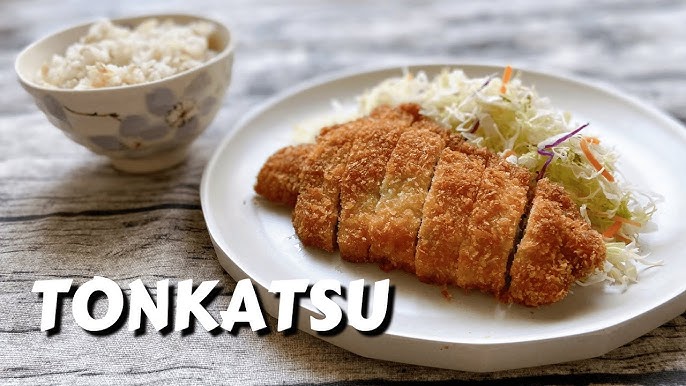Tonkatsu Recipe: Tonkatsu, a beloved dish in Japanese cuisine, is more than just a breaded pork cutlet—it’s a perfect blend of crunch, flavor, and comfort. With its golden, crispy exterior and juicy interior, tonkatsu has become a staple both in Japanese households and restaurants across the world. Whether you’re looking for a hearty lunch, a comforting dinner, or a new recipe to master, tonkatsu never disappoints.
What makes tonkatsu so special isn’t just the way it’s cooked—it’s the attention to detail. From selecting the right cut of pork to the specific method of breading and frying, each step adds something unique to the final bite. It’s not just about following a recipe; it’s about embracing a cooking tradition that has stood the test of time.
What Makes Tonkatsu Special?
You might be wondering, “Isn’t it just a pork schnitzel?” Not quite. While it shares similarities with other breaded meat dishes worldwide, tonkatsu stands apart because of its use of panko breadcrumbs and tonkatsu sauce. Panko gives it that light, airy crunch that’s hard to replicate, and the sauce—tangy, sweet, and savory—elevates every bite.
What’s more, tonkatsu can be enjoyed in so many ways. Served with shredded cabbage, alongside rice, in a sandwich (called katsu sando), or even as a topping for Japanese curry, its versatility makes it a favorite for many. It’s simple enough for beginners yet refined enough to impress any dinner guest.
Ingredients You’ll Need
Let’s kick off your tonkatsu adventure by going over what you’ll need. One great thing about this dish is that the ingredients are easily available, and there’s nothing too complicated or fancy.
Main Ingredients
- Pork loin or pork fillet (boneless) – 4 slices, about ½ inch thick
- Salt and pepper – to taste
- All-purpose flour – for dredging
- Eggs – 2, beaten
- Panko breadcrumbs – about 2 cups
- Vegetable oil – for deep frying
Optional Add-ons
- Cabbage – finely shredded, served as a fresh, crunchy side
- Lemon wedges – to add brightness
- Steamed rice – to round out the meal
- Tonkatsu sauce – homemade or store-bought
Keep it simple if you’re just starting out. But if you want the full Japanese diner experience, don’t skip the cabbage and rice!
Preparing the Pork Cutlets
This is where the magic begins. Good tonkatsu starts with well-prepared pork. That means choosing the right cut and treating it with care.
Choosing the Right Cut
Pork loin is the go-to choice for tonkatsu. It has the right balance of meat and fat, making it juicy and flavorful when fried. If you prefer something leaner, go for pork fillet (also called tenderloin). Just keep in mind that leaner cuts may require extra attention to keep them moist.
You’ll want each piece to be about ½ inch thick. Too thick, and the breading will burn before the meat cooks. Too thin, and you’ll miss out on that satisfying juiciness.
Tenderizing and Seasoning
Once your pork is portioned, use a meat mallet or the back of a knife to gently pound each piece. This not only tenderizes the meat but also helps ensure even cooking.
Next, season both sides of the pork with a generous pinch of salt and a dash of pepper. This simple seasoning goes a long way and enhances the natural flavor of the pork.
Pro tip: Let the seasoned pork rest for about 10 minutes before breading. It helps the flavors absorb into the meat.
Breading the Pork
Now that your pork is ready, it’s time to give it that signature tonkatsu crunch. Breading may seem straightforward, but getting it right is key.
Proper Dredging Method
Follow the classic three-step method:
- Flour: Dredge each piece of pork in all-purpose flour. Shake off any excess. This layer helps the egg stick better.
- Egg: Dip the floured pork into beaten eggs. Coat it evenly.
- Panko: Press the pork into a bed of panko breadcrumbs. Don’t just sprinkle—really press the panko on so it adheres well.
Be gentle but thorough. Uneven breading leads to uneven frying, and no one wants that.
The Importance of Panko Breadcrumbs
Panko is what gives tonkatsu its iconic crispy texture. Unlike regular breadcrumbs, panko is lighter and flakes rather than crumbles, creating a delicate crunch that’s hard to beat.
If you can’t find panko, try crushing dry white bread into coarse crumbs and toasting them lightly—still not quite the same, but a decent substitute.
Frying to Perfection
This is the moment of truth. Frying tonkatsu correctly is what separates a soggy disappointment from golden, crispy glory.
Best Oil and Temperature
Use a neutral oil with a high smoke point like canola, peanut, or vegetable oil. Heat the oil to 350°F (175°C). Too cool, and your tonkatsu will be greasy. Too hot, and the breadcrumbs burn before the pork is cooked.
Use a thermometer if you can. If not, test the oil with a small piece of panko—if it sizzles and floats to the top, you’re good to go.
Tips for Crispy Tonkatsu
- Don’t overcrowd the pan—fry in batches.
- Cook each side for about 3–4 minutes until golden brown.
- Let the cutlets rest on a wire rack, not paper towels. This keeps them crispy by allowing air to circulate.
Let the aroma take over your kitchen—it’s a sign you’re doing it right!
Making Tonkatsu Sauce
Sure, you could buy tonkatsu sauce from the store—but making it at home brings the flavor to life. It’s quick, customizable, and uses ingredients you probably already have.
Homemade Sauce Recipe
Here’s a simple and delicious tonkatsu sauce recipe:
Ingredients:
- 1/4 cup ketchup
- 2 tablespoons Worcestershire sauce
- 1 tablespoon soy sauce
- 1 tablespoon mirin (or a dash of sugar if you don’t have it)
- 1 teaspoon Dijon mustard (optional, for a tangy kick)
Instructions:
- Mix all the ingredients in a bowl.
- Taste and adjust to your liking—add more ketchup for sweetness or soy sauce for saltiness.
- Let it sit for a few minutes before serving to let the flavors meld.
This sauce is thick, tangy, and sweet—just the way it should be. Store any leftovers in the fridge for up to a week.
Store-bought Alternatives
If you’re in a rush or just want that authentic Japanese flavor, opt for brands like Bull-Dog Tonkatsu Sauce or Kikkoman. These are readily available in Asian grocery stores and even online. They come perfectly balanced, ready to drizzle over your cutlet.
Plating and Serving
Presentation isn’t just about looks—it affects how you experience the dish. Tonkatsu is best served hot, with the right sides and a bit of flair.
Classic Sides and Garnishes
Tonkatsu traditionally comes with:
- Shredded cabbage: Finely shredded and chilled. It cuts through the richness of the fried pork and adds a refreshing crunch.
- Steamed white rice: A neutral, comforting companion.
- Lemon wedges: For a citrusy zing that enhances the pork’s flavor.
- Miso soup: Optional, but adds a warm, savory contrast to the crispy cutlet.
You can also include a small dollop of Japanese mustard or wasabi on the side for those who like a bit of heat.
Presentation Tips
Slice the tonkatsu into strips before serving. This makes it easier to eat with chopsticks and shows off that juicy interior. Place it neatly beside a mound of cabbage, and drizzle some sauce on top—or serve the sauce on the side for dipping.
Want it Instagram-worthy? Sprinkle a few toasted sesame seeds or chopped parsley over the top. Small touches make a big difference.
Tonkatsu Variations
Once you’ve nailed the classic, why not experiment? Tonkatsu is a flexible recipe that opens the door to many tasty spins.
Chicken Katsu
Swap pork for chicken breast or thigh, and you’ve got chicken katsu. It’s just as crispy and flavorful but with a slightly lighter taste. The steps are the same—just make sure your chicken is cooked through.
This is a favorite with kids and picky eaters, especially when served in a bento box with rice and fruit.
Tonkatsu Curry
This is comfort food on another level. Serve your crispy tonkatsu on a bed of rice and pour over a rich, savory Japanese curry sauce. The contrast of crispy cutlet and smooth curry is pure magic.
You can find Japanese curry roux in most Asian supermarkets, or make your own from scratch using onions, carrots, potatoes, and curry spices.
Tips for First-Timers
Even though tonkatsu is beginner-friendly, a few pitfalls can trip you up. Here’s how to make sure your first attempt is a success.
Common Mistakes to Avoid
- Skipping the dredging process: Don’t rush the breading. Each layer matters.
- Using cold meat: Let the pork come to room temperature before frying.
- Overcrowding the pan: This drops the oil temperature and makes the cutlets soggy.
- Draining on paper towels: Always use a wire rack to keep the coating crispy.
Pro Tips for Beginners
- Double coat for extra crunch: Dip in egg and panko twice if you want an extra thick crust.
- Freeze the breaded pork for 15 minutes before frying: This helps the coating stick better and fry evenly.
- Invest in a kitchen thermometer: Temperature control is everything in frying.
Healthier Tonkatsu Options
Craving tonkatsu but watching your waistline? No worries—you can still enjoy this crispy treat with a few tweaks.
Baking Instead of Frying
Place your breaded pork on a greased wire rack over a baking tray. Spray or brush lightly with oil and bake at 425°F (220°C) for about 20–25 minutes, flipping halfway.
It won’t be quite as golden, but you’ll still get that satisfying crunch without the deep-frying guilt.
Air Fryer Tonkatsu
Air fryers are a game changer. Preheat your air fryer to 400°F (200°C). Spray the cutlets with oil and cook for 10–12 minutes, flipping once.
You’ll be surprised how crispy the result is—plus, it’s quicker and cleaner than traditional frying.
Pairing Tonkatsu with Beverages
A perfectly cooked tonkatsu deserves the perfect drink pairing. Whether you’re dining alone or hosting guests, the right beverage can elevate your meal from great to unforgettable.
Japanese Drinks
- Green Tea (Ocha): This traditional choice complements the rich flavors of tonkatsu and helps cleanse the palate between bites.
- Sake: A warm or chilled sake can bring out the umami in the dish, enhancing its overall depth.
- Asahi or Sapporo Beer: Crisp and slightly bitter, these Japanese lagers cut through the fattiness of the pork for a well-balanced experience.
Want something non-alcoholic? Try Ramune (a Japanese soda) for a fun, sweet fizz or Barley tea (Mugicha) for a refreshing, earthy contrast.
Western Pairings
If you’re not sticking strictly to Japanese tradition, here are some excellent Western drink options:
- Crisp white wine, like Sauvignon Blanc or Pinot Grigio, pairs wonderfully with fried food.
- Sparkling water with lemon keeps things light and refreshing.
- Craft beers with mild bitterness add complexity without overpowering the dish.
The key is to match the rich, crispy pork with something light, zesty, or slightly acidic.
Storing and Reheating Leftovers
Let’s be honest—Tonkatsu is so good, you probably won’t have leftovers. But if you do, here’s how to keep that crunch alive.
Best Practices
- Cool completely before storing – Place the cutlets on a wire rack to prevent sogginess.
- Wrap individually in foil or parchment paper, then place in an airtight container.
- Refrigerate for up to 2 days. For longer storage, freeze for up to 1 month.
Avoid stacking the pieces directly on top of each other—they’ll lose their crispness fast.
Keeping it Crispy
To reheat, skip the microwave if you want that crunchy crust back. Instead:
- Oven: Preheat to 375°F (190°C), place tonkatsu on a wire rack over a tray, and bake for 10–12 minutes.
- Air fryer: Reheat at 350°F (175°C) for 5–7 minutes.
- Skillet: Reheat over medium heat with a tiny bit of oil, flipping once to crisp both sides.
Microwaves are fast but will make your tonkatsu chewy and limp—not ideal.
Tonkatsu Around the World
Though rooted in Japan, tonkatsu has found its way into kitchens and restaurants worldwide, evolving as it travels.
Japanese vs Korean Katsu
In Korea, a version called donkatsu or dongaseu exists. It’s often larger, thinner, and sometimes served with a spicier or fruitier sauce. Korean-style donkatsu also tends to be served with a variety of sides like kimchi, potato salad, and even corn cheese.
Japanese tonkatsu, on the other hand, sticks more closely to the basics: rice, cabbage, and a sweet-savory sauce.
Both are delicious—just slightly different interpretations of the same concept.
Western Fusion
In the West, chefs are putting their own spin on tonkatsu:
- Katsu burgers – crispy pork or chicken katsu patties served in buns.
- Katsu tacos – fusing Japanese and Mexican flavors for something unique.
- Katsu sandwiches (Katsu Sando) – a favorite in Japan and now globally popular in bistros and food trucks.
These creative takes show how versatile and beloved tonkatsu has become around the world.
Nutritional Value
Let’s break down what you’re eating. Tonkatsu isn’t the lightest dish—but it’s satisfying and high in protein.
Calorie Breakdown
- One average pork cutlet (fried): around 300–400 calories
- With rice and cabbage: expect 600–700 calories per meal
- Tonkatsu sauce: adds around 50–70 calories depending on portion
If you’re watching your intake, consider baking or air-frying to shave off some calories.
Protein and Fat Content
Tonkatsu is a good source of:
- Protein: Roughly 25–30 grams per serving
- Fats: Mostly from frying oil and pork, about 20–30 grams
- Carbs: Comes mainly from the panko and side dishes
Balance it with vegetables and go light on the sauce for a more nutritious meal.
FAQs about Tonkatsu Recipe
1. Can I make tonkatsu gluten-free?
Yes! Use gluten-free flour, gluten-free panko, and tamari instead of soy sauce. You can even find gluten-free tonkatsu sauce or make your own.
4. Can I prepare tonkatsu ahead of time?
Pork loin is traditional and offers a good fat-to-meat ratio. Tenderloin is leaner and more delicate.
3. How do I keep the breading from falling off?
Make sure to pat the pork dry, dredge properly, and chill the breaded cutlets before frying. Avoid flipping too much in the pan.
4. Can I prepare tonkatsu ahead of time?
Yes, you can bread the pork and refrigerate it up to 4 hours before frying. For longer storage, freeze the breaded cutlets and fry straight from frozen (adjust time).
5. What sides go well with tonkatsu?
Shredded cabbage, steamed rice, miso soup, and pickled vegetables are all classic options that balance out the richness of the dish.
Conclusion
Tonkatsu is more than just a dish—it’s a culinary journey. From selecting the right pork to achieving that perfect golden crust, each step is both simple and meaningful. It’s comfort food, it’s celebration food, and most importantly—it’s just plain delicious.
Whether you’re making it for the first time or adding it to your regular recipe rotation, this step-by-step guide gives you everything you need to master tonkatsu at home. Serve it with pride, savor each bite, and don’t be afraid to add your own twist.
Happy cooking!



